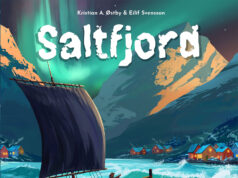 Stranger things have happened than a publisher capitalizing on popular culture for a game idea. Certain intellectual properties have become noteworthy recently that bring back the “kids as investigators” and weird tales concepts. This theme began somewhat in the late 70s and 80s with Steven Spielberg movies and combined with other media featuring mysteries of a supernatural or science fiction nature. In truth, it’s the result of a lot of different pop culture themes feeding off and encouraging others.
Stranger things have happened than a publisher capitalizing on popular culture for a game idea. Certain intellectual properties have become noteworthy recently that bring back the “kids as investigators” and weird tales concepts. This theme began somewhat in the late 70s and 80s with Steven Spielberg movies and combined with other media featuring mysteries of a supernatural or science fiction nature. In truth, it’s the result of a lot of different pop culture themes feeding off and encouraging others.
So, not surprising multiple publishers have made games about the same subject. The one being investigated in this review is Tales of Evil. It’s a storytelling/adventure game for 1 to 6 players which takes at least 2-3 hours per session and 6 chapters in the box means overall roughly 12-18 hours of gameplay. For the best experience, a minimum of 3 players is required.
Gameplay Overview:
Tales of Evil presents itself as a horror/adventure game with players taking on the role of tweens or young teenagers collectively solving mysteries. They’re called “Pizza and Investigation” and headquartered in a camper van that functions as a clubhouse. Each player will therefore take the role of one kid-investigator in the overarching mystery that begins.

A typical game involves reading the introduction from the storybook which then leads characters to various choices. This is very similar to Choose Your Own Adventure books with the added twist that many actions involve ability tests for one of the stats on each player’s character card. Players have health in 3 factors: Mind, Body, and Fear tokens to track health. If players lose all their Fear tokens, they reveal a new character card that resets their Mind, Body, and Fear tokens but gives them a drop in some stats.
The characters also carry equipment to aid their test rolls. To succeed in most tests, players roll several dice equal to the stat and need to achieve several success symbols. Equipment gives a boost to some rolls and additional mitigating techniques for bad rolls or to help other characters.
During play, the characters will move between locations represented on large boards showing an abandoned house and rooms. The storybook tells players which locations to move to and what choices are available in each location. If the players succeed through the various tests, they’ll manage to reveal more of the story and discover the narrative behind the house. Occasionally the game will throw tokens into the rooms that players occupy, offering chances to search for additional items or encounter various hazards.

Game Experience:
This reviewer has definitely played stranger things than this game. For the most part, the gameplay is pretty standard for a roleplaying/adventure game. The characters can take actions to do things in a somewhat non-flexible system and advance the plot by accomplishing various goals. All of this is pretty standard. Nothing revolutionary.

Now, the one twist the game does have is that the players at the table are integrated into the game through the use of the “Fusion” system. At certain times, the game will ask the players to do a task in the real world. If they can do the task, usually the characters gain some bonus. This provides an element of crossover from reality to fantasy which is somewhat the purpose of the game.
Unfortunately, both of the above can’t save the game from (and sometimes causes) a fundamental flaw. Over and over, it is made clear that the players are not the characters. The story reads third person past tense, unlike the 2nd person present narrative that a Dungeon Master or Choose Your Own Adventure novel would use. Instead of saying “You find the door to the dungeon.” the story will read “Mike found the door to the dungeon.” This choice abstracts the real-life players too much from their characters, and makes it feel like the player reading the text is the only one experiencing the story.
Even if the above can be forgiven, another self-induced error comes from the decisions themselves. Players will constantly feel like they’re being railroaded through a story. Sometimes in D&D this is ok, but if a game master does it too often, the players feel like they have no agency, they’re just making dice rolls. Such is the case here. What results, no matter how well the story is written, is a flat narrative.
Final Thoughts:
There are some things players expect from an adventure game. Tales of Evil starts with those same tropes and adds some stranger things that keeps players from being engaged. The game takes a theme that seems primed for lots of interesting gameplay and then squanders it with a hampered game structure and writing style that makes it all fall flat. When players should be taking the initiative to discover things and reveal clues, the game bends over backwards to show players a clue and hamper them with random irrelevant events. Players in love with the “kids as investigators” theme might have the patience to make this work, but for anyone else, the experience is frustrating.
Final Score: 2.5 stars – Even with some solid writing, the overall structure and lack of choices dooms this title.
Misses:
• Non-engaging use of first person
• Players can’t make meaningful choices
• Fusion system doesn’t really keep players coming back
























“Mike found the door to the dungeon.” is third-person past tense. First-person would be, “I found the door….”
Whoah, thanks for catching that GamerVic. I’ll correct that.